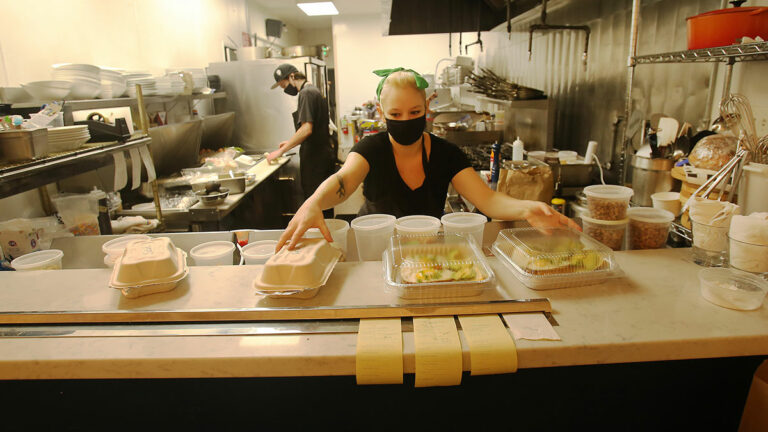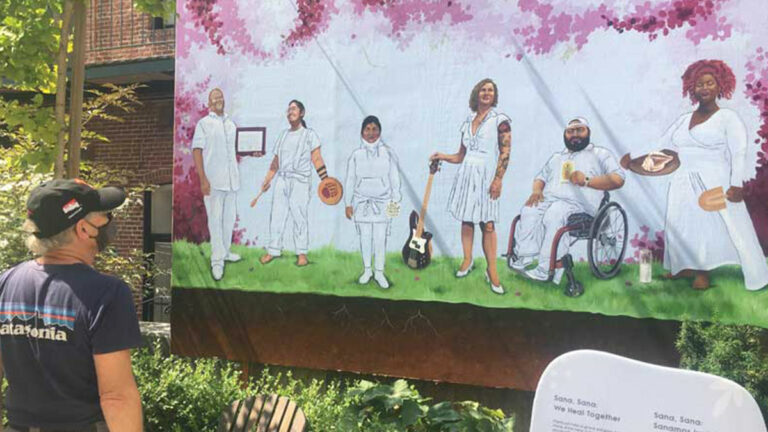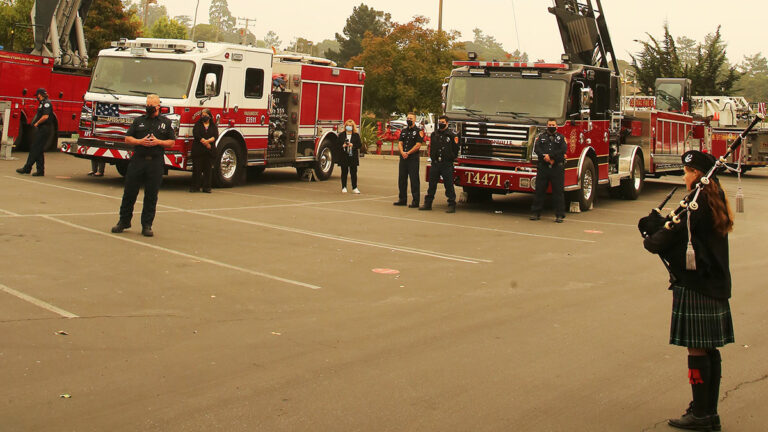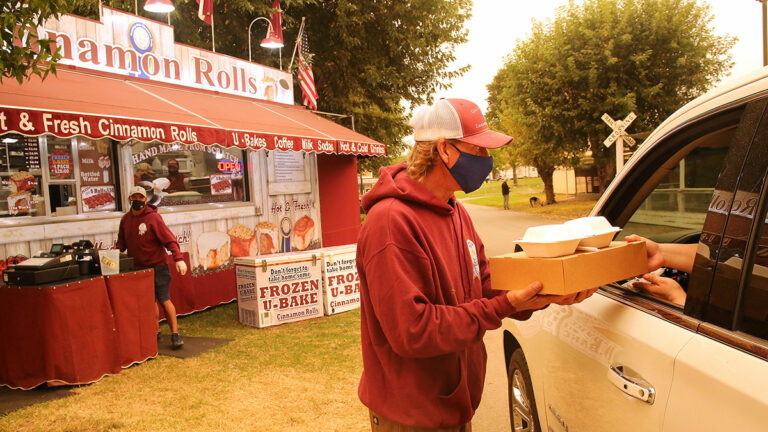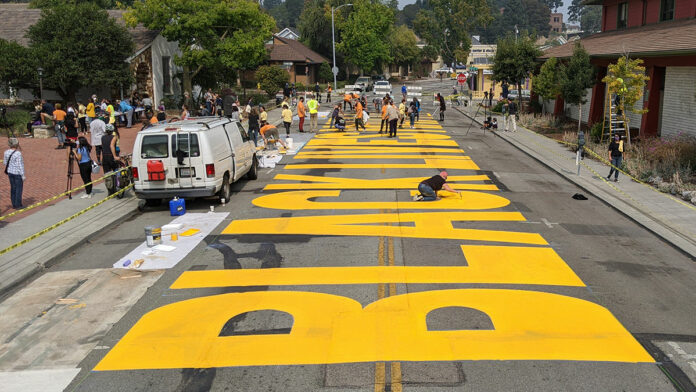Protests have been taking place across Santa Cruz County in support of the Black Lives Matter movement following the death of George Floyd, a Black man who was killed in Minneapolis on May 25 after a white police officer knelt on his neck for nearly nine minutes.
In addition to the nationwide calls for police reform and defunding, locally these protests have expanded to address such issues as the death of 21-year-old Tamario Smith at the Santa Cruz County Jail on May 10, the rights of the Black transgender community, and more.
Check back here for continuing coverage of local action, including links to full stories and details about planned community events. The most recent updates are added at the top.
Sept. 14, 10:30am: Black Lives Matter activists paint new mural
Even as clouds of smoke blanketed the skies on Saturday, Sept. 12, the haze that filtered in from fires around California wasn’t the only thing in the atmosphere.
During a Black Lives Matter mural painting at Santa Cruz City Hall, the air was also filled with hope, as excitement and positivity flowed through a socially distanced crowd. More than 500 people volunteered to paint the city’s permanent Black Lives Matter mural on Center Street that the Santa Cruz City Council unanimously approved in June.
Activists will repaint the mural every year. Organizers say it’s part of a broader, ongoing conversation that’s continuing to gain momentum, three months after the killing of George Floyd by Minnesota police in May.
“That’s the point of all this,” explained local artist and activist Abi Mustapha, who first came up with the concept, based on similar models around the country, and pitched it to the city. “It’s not just a performative act; there’s a lot more behind it.”
On July 8, the Arts Commission pledged to fund the mural’s maintenance, pick an organization each year to oversee the annual repaintings and to release an annual report on the committee’s commitment to “Equity, Inclusivity and Environmental Justice.”
The Yoga For All Movement, a Santa Cruz nonprofit that takes its practices into jails and rehab centers, sponsored the inaugural event. Each year, the chosen group in charge of the mural repainting will have to show what it has accomplished over the previous 12 months on racial equity, LGBTQ+, environmental and human rights issues in the community.
Mustapha said Santa Cruz is the first city in the country to incorporate a sustainability and equity initiative into its Black Lives Matter mural.
Families and people of all ages waited in line for the chance to paint a portion of the historic mural, while other volunteers worked on sanitization and crowd control. Organizers even set up a booth selling commemorative T-shirts with proceeds going toward future mural maintenance.
Mustapha’s friend Taylor Reinhold, an artist and activist, was among the volunteers, as were his fellow members of the Made Fresh Crew, whose murals can be seen throughout town.
At the event, Keisha Browder, CEO for United Way of Santa Cruz County, addressed the crowd.
“Enjoy the rest of this afternoon, but remember that Black Lives Matter as a mural—it matters in the boardroom, and it matters as policy,” Browder told the crowd. “It matters how we treat people.”
She later told GT that, going forward, activists, politicians and community members will need to keep working together to create equal access to quality education and housing, while shining a brighter light on problems in the criminal justice system. But she also said the turnout and unanimous vote “speaks to the heart of Santa Cruz.”
“I have to say I do feel seen, heard and valued in Santa Cruz,” she said.
Sept. 4, 5pm: Action continues with fundraisers, murals and more
Local organizing group Blended Bridge continues to take action to support racial justice in the community. The group recently collected school supplies for Beach Flats youth. It is currently collecting school supplies for Campesino families in Watsonville. Learn more about what they are collecting and how to contribute here: instagram.com/p/CEndkXSg__M.
More upcoming events for communities in need and for racial justice can be found on the Blended Bridge website and on the IndyBay calendar.
The Santa Cruz Museum of Art and History (MAH) is hosting an event where a Black Lives Matter mural will be painted on Center Street in downtown Santa Cruz. The MAH is inviting people to sign up as painters, sanitation helpers, and speakers at an open mic for the mural event on Sept. 12 from 10am-5pm. Learn more and sign up here before Sept. 10: santacruzmah.org/events/blm-mural/2020/09/12.
Aug. 17, 12:15pm: Organizers continue call for justice
Local organizers are continuing to hold events to bring attention to the movement for social justice.
The latest action comes on the heels of Santa Cruz’s first Black Lives Matter Month, which activists noted was marked by a string of racist incidents and hate crimes. As Black Lives Matter activist Esabella Bonner shared, they’re working to use last month’s incidents as a tool for educating people about the role of racism locally. They’re trying to provide resources to keep up the momentum for change.
“This backlash has been motivating for me because people wouldn’t be pushing back if we weren’t disrupting the status quo and we weren’t making changes. Long term, these changes are going to have a positive effect on everyone—even the folks that might have more reservations right now,” Bonner said.
A Defund the Police Coalition’s People’s Mic and March is planned for Tuesday, Aug. 18. The Santa Cruz group of the Showing Up for Racial Justice network is coordinating a car caravan in support of the event.
On Aug. 25, Santa Cruz Skateboarders Against Police Brutality will meet at Lighthouse Point on West Cliff between 3-4pm for a protest.
More events are also being added on the IndyBay calendar.
Aug. 5, 1:20pm: March tonight and more upcoming events
A march and speak-out for social justice are planned for tonight at 6pm in Santa Cruz. Anyone interested in participating is asked to meet at the Cowell Beach parking lot for the march to the Santa Cruz Lighthouse. More information is available from organizing group Blended Bridge.
There are also many more events planned for the continued effort toward social justice, including virtual events from NAACP Santa Cruz and other community leaders. On Sunday, Aug. 9, Santa Cruz County Clerk Gail Pellerin will moderate a panel discussion about women’s suffrage and the continued struggle for voting rights. Learn more about the virtual event here.
July 31, 11am: Black Leadership Panel today
A Black Leadership Panel today will feature several community leaders discussing their experiences as organizers in the social justice movement and what it means to be Black in Santa Cruz.
Thairie Ritchie, Faith Brown, Ayo Banjo, and Esabella Bonner will be on the panel discussing intersectionality and racial injustices that are often dismissed in local government. Learn more about the event, which will be held on Zoom starting at 2pm today, at blendedbridge.com/upcomingevents.
The event comes at the end of the first Black Lives Matter Month in Santa Cruz. In an open letter this week, community organizers reviewed what had happened throughout the month, including several documented and suspected hate crimes.
In an introduction to the letter, Bonner wrote that the first Black Lives Matter Month ultimately “felt like a not so subtle attempt to distract and deter attention from the main goals at hand—policy and sustainable change in our community.”
“It is my hope that we continue to work toward actionable policies and acceptance within our community for the years to come,” she added. Read the full letter here.
July 15, 12pm: UCSC NAACP calls for action
The UCSC NAACP called for better communication and a more direct response from campus officials following what campus police have described as a possibly “bias-related incident.”
The UCSC Police Department said in a statement last week that it is “investigating the suspicious circumstances surrounding a piece of rope that was strung from a street sign near the campus entrance” on July 2.
In an open letter this week, the UCSC NAACP said it “is appalled both by the boldness of people to intimidate Black lives by echoing the racial violence of past lynching, and by the following complicit nature of our institutional systems to not communicate effectively to the populations which may be directly impacted, such as our Black student leaders.”
The UCSC NAACP said that a statement last week from UCSC officials “falls short of describing what will be done to ensure tangible support and bolster resources for the Black community on campus.”
“Merely suggesting for folx to reach out for support is not nearly enough of an action-based reaction on behalf of the University,” the UCSC NAACP added.
In their open letter, which the NAACP Santa Cruz also signed on to, the group asked what steps UCSC will take to ensure the people responsible for the incident will be held accountable. They called for a “complete and full investigation into the perpetrators of this racist act,” including “a direct and correlated response” from UCSC and the UCSC police and updates about the case to groups including the campus NAACP.
Anyone with information regarding the incident can call the UCSC Police Department at 831-459-2231, extension 1, to speak with an officer.
July 13, 2:45pm: SCPD tracking reported hate crimes
The Santa Cruz Police Department issued an update Thursday on four reported hate crimes that have occurred in the city this year.
Two of those incidents met the legal standard of a hate crime, according to SCPD. Police are working with the District Attorney’s Office on pursuing charges in both cases.
Those two hate crimes occurred in Santa Cruz on June 28 and July 5. In the June 28 incident, the suspect launched an unprovoked attack on a man from Jamaica and used racial epithets during the assault. The victim sustained serious but non-life-threatening injuries, including a fractured orbital and a laceration requiring stitches. In the July 5 incident, a white man started slashing with a knife at a Black man while screaming racial slurs. That case was also forwarded to the FBI for review since a weapon was involved.
“Hate crimes have consequences far beyond the criminal act itself,” SCPD said in its statement Thursday. “These offenses not only cause lasting trauma to the victims, but they also impact our community with fear and exclusion.”
Two other suspected hate crime cases are still under investigation. One appeared to be hate crime based on language used about a person’s sexual orientation, according to SCPD spokesperson Joyce Blaschke. The other incident was June 18 at Alderwood, when a group started yelling “White America” and a homophobic slur at an off-duty chef, who is Filipino and has said he’s confident that racial bias played a role in what happened.
“These two cases involve unsettling name-calling and insults, but the individuals involved have elected not to press charges,” SCPD said.
The four reported hate crimes this year follow two in 2019 and 10 in 2018. Noting that hate crimes are often underreported, SCPD said they “accept and review all bias-related reported crimes.”
Anyone who is a victim of or witnesses a suspected hate crime can call 911 or reach SCPD at 831-471-1131.
July 8, 5pm: Paddle out for Tamario Smith, Black Lives Matter actions planned for this week
Several local events are coming up to continue the call for social justice. On Saturday, July 11, the Indigenous Surf Club is organizing a paddle out for Tamario Smith at Cowell Beach starting at 6pm. Smith, a 21-year-old, died in custody at the Santa Cruz County Jail on May 10. The Santa Cruz County Sheriff’s Office said Smith died of acute water intoxication. Smith’s family says that claim has left them with more questions than answers.
There are also Black Lives Matter marches scheduled for Thursday in Scotts Valley and Saturday in the San Lorenzo Valley. Meanwhile, Watsonville’s Fruition Brewing has joined “Black is Beautiful,” an initiative aiming to raise awareness of racial injustice. On Monday, the brewing company released a beer for which 100% of the proceeds will go to the American Civil Liberties Union. Our partner paper The Pajaronian has more details in their story.
July 8, 4:30pm: More racist incidents in Santa Cruz
More suspected hate crimes continue to be documented in Santa Cruz as people across the country call for action to address systemic racism and injustice.
On Sunday, July 5, a white man started slashing with a knife at a Black man while screaming racial slurs, according to the Santa Cruz Police Department. The incident happened at San Lorenzo Boulevard and Broadway Street. Police arrested the suspect, 43-year-old Ole Hougen, and charged him with a hate crime and assault with a deadly weapon.
The suspect said he only wanted a “white person to help” take him into custody, SCPD said. In their Facebook post about the incident, the department added that’s “not an SCPD accommodation. Our staffing includes people of color. Mr. Hougen continued to make racial comments and slur towards SCPD officers and jail staff during the booking process.”
Anyone who is a victim of or witnesses a suspected hate crime can call 911 or reach SCPD at 831-471-1131.
The UCSC Police Department is investigating a July 2 incident that they say may be “bias-related” after a piece of rope was strung from a street sign near the campus entrance.
“At this time, this is not classified as a crime, and we do not know the motives of the individual that left it there,” according to a UCSCPD press release. “Nonetheless, this incident is deeply troubling to those that observed it, and may be considered a bias-related incident.”
The department shared a video that shows four people gathered as one of them throws the rope onto the sign around around 9:45pm on July 2. Anyone with information regarding the incident can call the UCSC Police Department at 831-459-2231, extension 1, to speak with an officer.
On Tuesday, the city of Santa Cruz said that the community memorial, or Ofrenda, at the Town Clock was vandalized during the weekend. The city said in a tweet that it saved the materials from the memorial, which can be claimed at the Civic Auditorium through noon on Friday, July 10. “Our hearts go out to those participants whose items were damaged, and we welcome the community’s help in protecting this important space for expression,” the city added.
July 2, 4pm: Action continues for racial justice
It is Black Lives Matter Month in the city of Santa Cruz, where the city council voted unanimously last week to install a Black Lives Matter Mural and to display Pan-African and Black Lives Matter flags in front of City Hall during the month of July every year.
Action for racial justice continues across the county, too, including a march and speak-out that drew several hundred people in Capitola on Wednesday.
Coming up, a block party is planned in downtown Santa Cruz on Saturday, offering a space for “building community with fellow abolitionists while enjoying speakers and music,” according to an event poster. The event will start at the clocktower at 1pm, with a march beginning at 4pm.
There’s also a San Lorenzo Valley Black Lives Matter Protest planned for Saturday, July 11, starting at 10am. More info can be found on the Black Lives Matter SLV Facebook page.
At least one local company is participating in Blackout Tuesday on July 7. Treehouse, a Santa Cruz-based cannabis dispensary, said it will close on July 7 and encourage people to shop only at Black-owned businesses on that day. The company will additionally donate all of its profits from its apparel sales this month to the Last Prisoner Project, which works to reduce jail and prison sentences for cannabis-related charges. Law enforcement in the U.S. disproportionately charges Black people with cannabis-related crimes.
At least two allegedly racist incidents have happened in Santa Cruz in recent days, including a suspected hate crime on Sunday and an incident at Alderwood that fueled calls to boycott the downtown restaurant. Last week, we also covered a Facebook post by former Santa Cruz Police Chief Kevin Vogel, who announced he was cancelling his Netflix subscription. Although Vogel did not offer specific context, he not-so-subtly hinted that the cancellation was because Netflix CEO Reed Hastings donated $120 million to historically Black colleges.
In this week’s cover story, local leaders including Santa Cruz Mayor Justin Cummings discussed the history of predictive policing in Santa Cruz and the questions that the now-banned technology raised about racial bias. Going forward, Cummings says, he wonders if technology could be used “not for predictive purposes, but for evaluating police departments.”
Cummings talked about calls to defund the police, too.
“We need to have all pieces in place before we start cutting funding from different departments,” he says. “And that’s what this conversation will be all about—how do we want to be policed, what does public safety look like for Santa Cruz, and how can we do so in a way that ensures equal protection for everyone?”
June 19, 1pm: “What Happened to Tamario Smith” Protests Point Finger at Santa Cruz County Sheriff’s Office
Three things could be heard as roughly 150 demonstrators, armed with banners and signs, marched from the downtown Santa Cruz clock tower over the Water Street bridge.
The first was a marching snare drum beat, and the second was the recurring chant of “Say his name,” followed by “Tamario Smith!” The third was the wailing cries of Smith’s family members as they led the procession toward Santa Cruz County Jail to raise awareness about the death of the 21-year-old, who had been incarcerated at the facility when he died May 10.
“The facts are not adding up,” said criminal defense attorney Jonathan Gettleman, addressing the crowd. Gettleman and his wife, Elizabeth Caballero, specialize in cases of police abuse, misconduct and in-custody deaths. They have agreed to take on Smith’s case pro bono.
According to the Santa Cruz County Sheriff’s Office, Smith was found unresponsive in his jail cell, and attempts by paramedics to revive him were unsuccessful. According to his obituary, Smith was born in Stockton but moved to Santa Cruz with his family in 2001. He had been in custody since January.
Under both Sheriff Jim Hart and his predecessor Phil Wowak, the sheriff’s office has faced scrutiny for its medical services, inspection procedures and deaths at the jail. Consecutive Santa Cruz County Grand Jury reports about the jail in 2014, 2015, 2016, and 2017 all called for improvements.
Smith’s family organized the protest and march to bring awareness to his case and to ask why Smith died. It’s a question that was left unanswered until just hours before the demonstration took place, when the sheriff’s office distributed a press release.
The release stated that Smith died of “acute water intoxication, due to the over-consumption of water in a short period of time.” The media release adds that Smith drank too much water, leading to an electrolyte imbalance, because of “underlying mental health issues.”
Acute water intoxication, also known as hyponatremia, can cause death when a person’s kidneys become unable to process water quickly enough, diluting the body’s sodium levels.
Gettleman said Smith had serious kidney issues and that he begged for help but did not get it.
The sheriff’s office’s media release has left the Smith family with more questions than answers. How did Smith get access to that much water, and why did it take so long for guards to find him “unresponsive?” Also, why was he not given the proper medical attention?
“It’s bullshit,” Tamario’s twin sister, Tamia Warren-Smith, tells GT. She said her brother was a natural protector and cared about those around him, from family members to homeless people in the community. Because of that, Smith says her family isn’t done asking questions about what happened to her brother.
“It’s never going to end,” she says.
Organizers are holding a Juneteenth protest, aimed at spreading peace and solidarity, today, June 19, at 5:45pm. They’ll be meeting at the Louden Nelson Community Center.
Read our continuing coverage of the local protests and policy discussions.
June 16, 9am: Juneteenth Peace March planned for Friday
As protests against police brutality continue across the country, an upcoming youth-led peace march in Santa Cruz aims to raise awareness about systemic racism locally.
The Juneteenth Peace March is intended to “create a platform to hear from youth, poets, historians, spiritual leaders, mental health advocates and formerly unhoused members of our community on systemic racism in Santa Cruz and stand in solidarity with the Black Lives Matter movement protesting police brutality nationwide,” organizer Thairie Ritchie said in a press release.
The march is planned to start at 5:45pm on Friday, June 19, at the Louden Nelson Community Center. The march will proceed down Center Street to a speak-out in front of Santa Cruz City Hall from 6:15-7:45pm. The organizers are asking people who attend to wear a mask and practice social distancing by keeping six feet apart.
If you know of upcoming racial justice events in Santa Cruz County, please email ca******@*******es.sc so we can write about your event here.
One way people are supporting the racial justice movement is by shopping at Black-owned businesses. The Downtown Association of Santa Cruz has been featuring local Black-owned businesses on its Instagram. The NAACP Santa Cruz is crowdsourcing a list of Black-owned businesses in Santa Cruz and Monterey counties. There’s a crowdsourced list just for Santa Cruz County, too.
Read our continuing coverage of the local protests and policy discussions.
June 5, 5:30pm: Protests continue in Santa Cruz
Emotions and tensions ran high for the second straight evening in Santa Cruz, as protesters turned out for another Black Lives Matter demonstration on Thursday, June 4. The three-and-a-half hour protest remained peaceful but was followed by the tearing down of barrier fencing surrounding a post office and the spray-painting of the police station for a second time.
Roughly 250 people gathered in front of the clocktower at the intersection of Pacific Avenue and Water Street, blocking what little traffic there was until the police cordoned off the area.
The crowd gave several demands to Mayor Justin Cummings: keep the Santa Cruz Police Department away from Oakland, provide comfortable housing to all homeless people, the “dissolution of all cops,” the 100% defunding of the Santa Cruz Police Department, and freeing all prisoners and closure of all Santa Cruz County jails.
Read more about Thursday’s protests in the full story here.
June 4, 5:30pm: Policing policies being discussed
With Black Lives Matter protesters across the nation filling the streets in daily calls to action after the killing of George Floyd at the hands of Minneapolis police, the city of Santa Cruz and its police department have reached out directly to the public.
On Wednesday, June 3, Mayor Justin Cummings, City Manager Martín Bernal and Police Chief Andy Mills held an online discussion titled “Changing the Culture of Policing” and looked at how it will change in the future.
Cummings opened the online discussion by saying it was Mills who reached out and initially started the dialogue.
“We decided to pull together this forum for our community, so people could speak directly to their elected officials and police chief while social distancing,” explained Cummings.
After that, the floor opened up for a few words by local activists and organizers of the most recent local Black Lives Matter protests—one of which was happening at the same time as the webinar.
When it came Mills’ time to talk, he wasted no time discussing how he is changing the policing policies of his department.
“Today, I issued an order to my entire department that we’ve changed our policy and will no longer use the carotid restraint, also known as the ‘choke hold,’” he said. “It’s done.”
Floyd was killed not in the carotid restraint but with a knee on his neck, a controversial maneuver that became infamous after the 2014 killing of Eric Garner by New York City Police. Since Floyd’s death on May 25, dozens of police departments in California, including San Diego and Watsonville, have banned the technique.
“It’s low-hanging fruit, but it’s a good place to start,” Mills said.
Read more about the policy changes being proposed in the full story here.



